Agentforce, the GenAI Agent by Salesforce

IoT and RPA are key levers of modernization in the Industry 4.0, which once combined, can open up many opportunities and represent an easy solution to link the physical world and the digital world
Many firms, especially those operating in industry, have been strongly impacted by a new wave of technological innovation in recent years. This wave signifies a 4th industrial revolution, or Industry 4.0, and brings with it a new era full of change and opportunities as well as important challenges for its actors.
This transformation not only translates into investment in better machines, but also investment in new technologies and new skills needed to revamp the entire production line.
This transformation is largely based on new digital technologies that allow companies to improve their flexibility, productivity and responsiveness in markets with global competition, as well as with ever shorter production lead times in a world where consumers or customers demand personalised products as soon as possible.
This trend is global and widespread, as evidenced by the following figures; by 2020:
80% of companies will have digitised their value chain;
18% greater productivity is expected through industrial digitisation;
~1 billion connected objects will be present in factories, resulting in a significant multiplication in the volume of data produced.
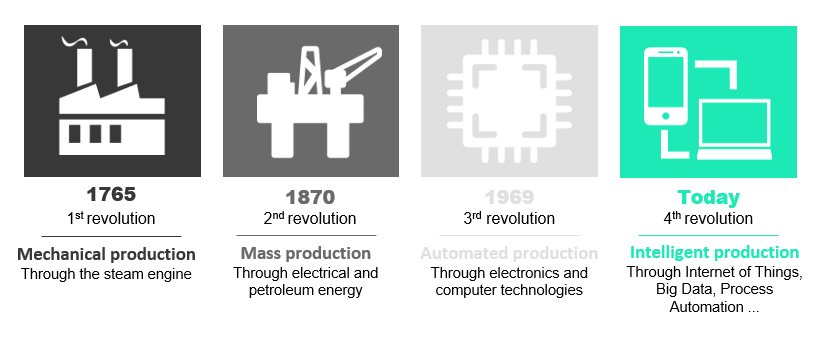
Industry 4.0 is comprised of several large innovation families, among which both IoT (Internet of Things) and RPA (Robotic Process Automation) are considered important levers of modernization and process improvement. While IoT offers information gathering and physical world response capabilities, RPA makes it easy to automate processes based on data and commands from different systems. Combining these two technologies opens up many opportunities and an easy solution to link the physical world and the digital world. Sia Partners will now detail the implications of combining these technologies and review a number of existing use-cases.
To better understand the opportunities of combining IoT and RPA, it is important to understand the opportunities they each offer individually.
Through its data gathering and actuator capabilities, IoT widens the use-case landscape for objects, machines, robots and factories. With its ability to digitise the physical world, IoT adds value by:
Improving processes and modes of operation;
Optimising the allocation of resources (human, technical or financial);
Anticipating users' needs or operational incidents via predictive maintenance tools;
Improving existing services or launching new services.
To reach its full potential, the objects and data journey as a whole must meet various criteria in order to guarantee data integrity, data usability and, eventually, the ability to act on their environment in optimal conditions. These are unprecedented technological challenges that every firm needs to understand:
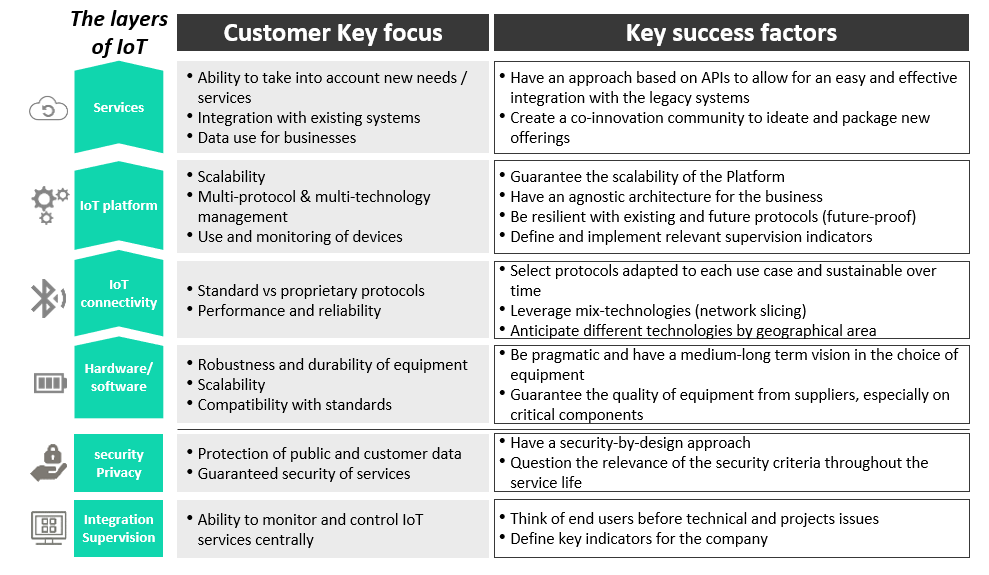
The main difficulty today is not the ability to connect an object, but rather the ability to use the data produced by said object. This data is linked not only to its immediate environment but also to related business services. For example, why install sensors (temperature, pressure, electrical intensity, ...) on a production machine that identify the causes of a failure if no action is taken (automatic shutdown of the machine if necessary, automatic speed control, ...)? In this case, RPA can be introduced to solve this challenge.
RPA is a technology that imitates human actions in digitized systems to automate business tasks and processes via robots that have the advantage of being very fast, accurate, scalable and available 24/7. As a result, they provide substantial gains in operational efficiency by automating repetitive, irritating or low value-added tasks, allowing employees to spend more time on either analysis or customer-oriented activities.
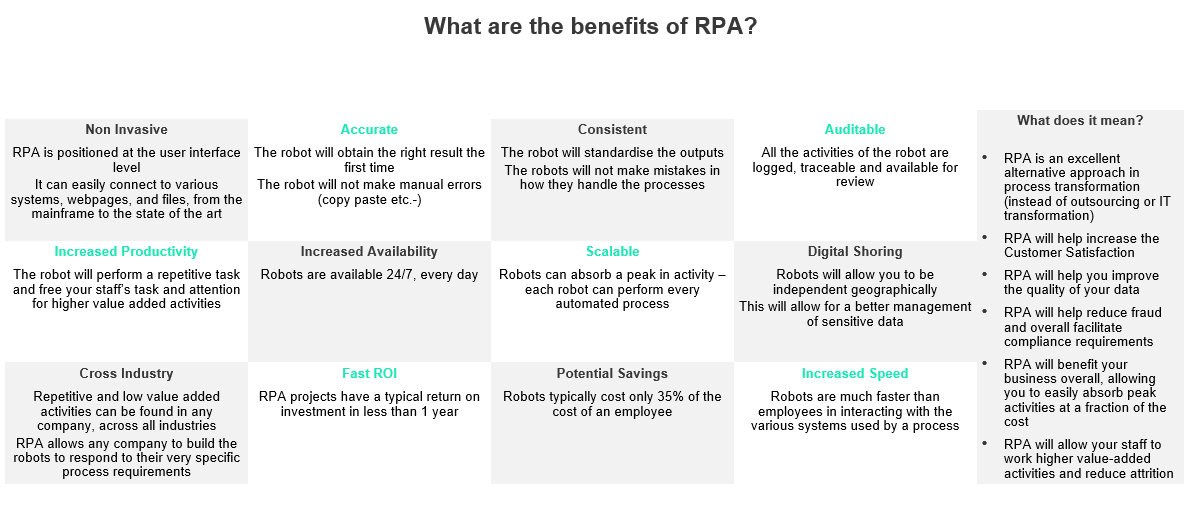
RPA is a lightweight process transformation option which does not require modifying or changing the existing systems or processes. The implementation of RPA is simple and flexible as the robots reproduce the same activities as employees, in the same UIs and environments. Each automation is adapted to the specific needs of the firm. The ideal processes for RPA are those with:
Manual and repetitive tasks: tasks performed by human operators on their computer, with a high touch time and volume.
Predefined rules: the processes follows simple rules that can be modelled on a decision tree, and are not based on human judgement.
Structured digital inputs: inputs must be fully digital, structured and standardised.
Low exception rate: ideally, there should be a low volume of exception when operators execute the processes
Stability of both the process and the underlying information system: RPA mimics human activity ; it cannot fix a broken process or a broken system.
Given the amount of data generated by connected objects (IoT), RPA makes it possible to leverage a new type of resource (the software robot) to quickly treat this large volume of data. RPA enables the execution of processes around the IoT-captured data, their integration with the systems, and, if necessary, the triggering of actions in the systems leading to responses in the physical world through the IoT chains. As we’ve seen, the data generated by IoT connectors is a good fit for RPA automation.
Today, few IoT projects have gone beyond the pilot stage, much less a Proof of Concept, as most firms still want to review the technical feasibility, economic viability and business case relevance. Should the result be positive, then a firm may consider a wider roll-out of the use-case.
The best way to demonstrate use-cases of improved performance, increased productivity or reduced costs, is to associate sensor and object data with other data or digital services already present within the firm, based on the principle of the physical-digital-physical loop:
Physical world: the connected objects capture the relevant data to exploit,
Digital world: the information systems receive the data to allow for analysis and tasks to be performed,
Physical world: the instructions from the systems are automatically inputted into the objects to perform the scheduled tasks.
This loop will lead to different benefits for the industry:
Decreased asset repair and maintenance costs: being able to model asset behaviour to predictably eliminate defects and errors results in reductions in both maintenance costs and machine downtime.
Improved compliance with regulatory and industry standards: real-time monitoring of working conditions on an industrial site makes it possible to ensure compliance with the protocols in place throughout the production chain. Compliance with said protocols is critical, as failure to do so can lead to significant fines (e.g., non-compliance with sanitary conditions in the food or pharmaceutical industries).
Improved monitoring of efficiency and productivity: tracking space use and measuring actual output versus projected output using a computer model, as opposed to monitoring from the ground, can both significantly reduce spending and increase business efficiency.
RPA makes it easier to inject IoT-generated data (from sensors and objects) into the firm's various systems, or even third party systems. This combo with process automation can thus be achieved without changing the systems or developing a specific connector. As an added benefit, IoT use-cases and prototypes can be tested much more easily, comprehensively, promptly, and without significant added costs (system development) that can be hard to justify so long as the benefits of the use cases are not demonstrated.
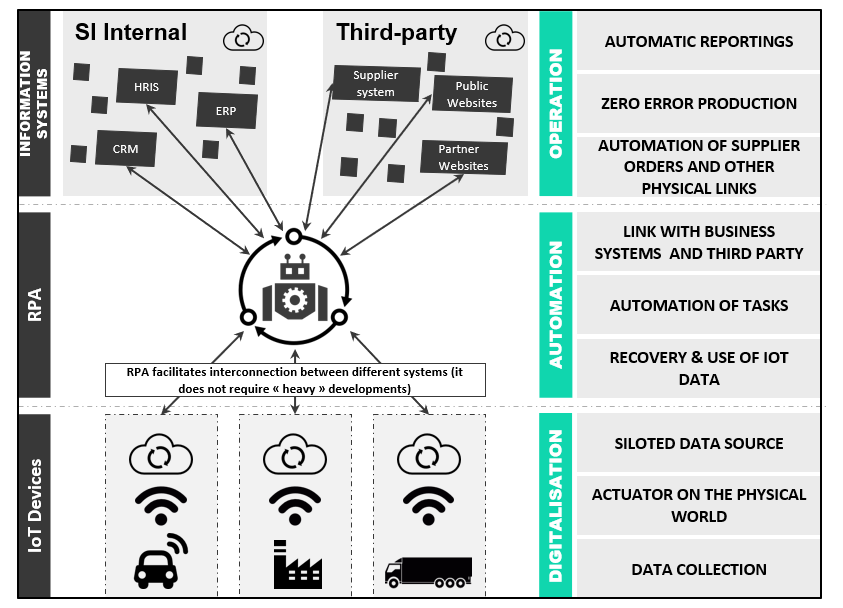
The complementarity of RPA and IoT is illustrated by several use-cases within Industry 4.0.
With predictive maintenance, firms can better keep their production lines in optimal operational condition and improve the business continuity - or at least limit the disruption time - of their service(s), thus optimising production's performance and overall service quality.
Example: a Bosch-Rexroth factory, located in Homburg, in Germany’s Saarland, experienced regular bottlenecks in the manufacture of electro-hydraulic valves for agricultural machinery. The company decided to upgrade its production line based on the capabilities offered by Industry 4.0:
Automatic ergonomic adjustment of the workstation and/or the machine based on the operator and its skillset. Operators wear an RFID chip in their clothes, allowing for an automatic adjustment of the relevant tools.
Production line, product and inventory status data is sent in real-time to the MES[2]and the ERP[3], with autogenerated reporting.
This new production line is based on the previously mentioned data path:
IoT system sensors enable the collection of relevant data on products, the operator and the production chain in general,
Software robots enable the automated machine adjustment tasks or real-time reporting push.
Bosch-Rexroth’s strategy for the digitization of its production chain allowed them to integrate the classic benefits of automation: productivity gains, maintenance quality improvement, reliability of the machines and energy savings. The new production line allows the operator to start almost instantly, whereas previous lines required 5 to 30 minutes to launch: a productivity gain of 10%. Finally, the stock level has decreased from 2 days to less than 24 hours [4].
Another existing use-case is in smart supply chain management. Here, the use of connected objects enables data collection on current stock (quantity, temperature, transport time ...) for real-time analysis and correlation to customer consumption data. The results of these analyses are used to define replenishment control automation scenarios for the purpose of proactive replenishment.
Cdiscount, one of France's e-commerce leaders, has decided to adopt a smart supply chain management solution by partnering with Relex Solutions. This collaboration aims to modernise Cdiscount by developing forecasting and replenishment automations for their entire product catalogue :
Data Sensors are used in warehouses to track stock variations in real time,
Collected data are cross-checked against customer order tracking data, and predefined stock management business rules,
The results lead to a number of "decision" scenarios
The decisions are sent to the software robot to trigger automatic replenishment.
In this way, inventory & replenishment management is faster, smoother and more efficient, by following the flow mentioned earlier:
IoT system sensors enable the collection of relevant data on the firm's warehouse stock customers' orders ,
Software robots enable the automation of replenishment orders and free up the time spent by the operator in data collection, analysis and decision-making.
Relex's solution improved the automation of order forecasting calculations, allowing operational staff more time to focus on value-added tasks, such as advanced stock fluctuation analysis and customer requests, to optimize automatic ordering.
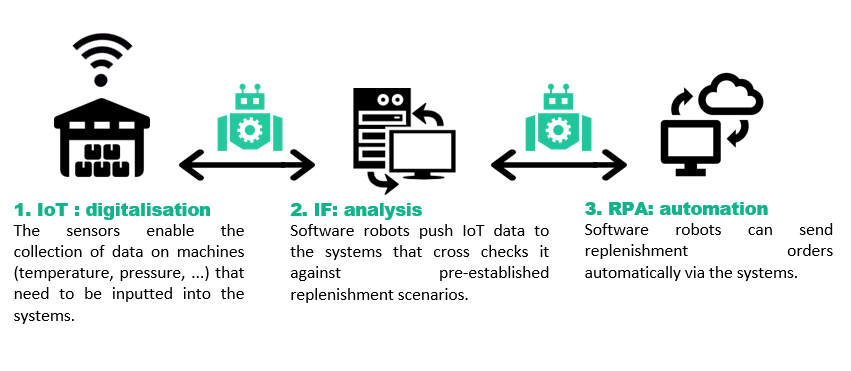
The Internet of Things is a thriving ecosystem: constantly innovating, introducing new services and expanding into new markets. One of its main uses is to collect and analyze different datasets. RPA allows IoT to easily open up to the digital world based on these datasets. These innovations will lead to substantial benefits, by optimizing costs and providing a tremendous competitive advantage, especially in the industrial sector.
Sia Partners supports industrial players in the implementation of IoT services across the entire communications chain and their association with business applications. We work most notably in the transportation sector, where a number of control or verification tasks can be automated to improve both efficiency and safety by allowing employees greater time to focus on key risks. RPA allows us to easily create automated business processes based on the datasets collected by the different sensors.
Moreover, the combination of these technologies is not limited to the industrial sector, but is also applicable to everyday life. IFTTT (IF This Then That), a smartphone app proposing short automations, is one example. One of its many use-cases: automatically switching on your front-dor light via a smart home device (smart light) when a pizza delivery person approaches your home, thanks to geolocation data (currently available only in the US).
The combination of IoT and RPA is now a reality, both for firms to facilitate the establishment of new services, and for individuals to automate a number of everyday tasks.
Source : PWC survey
Source : Bpifrance study